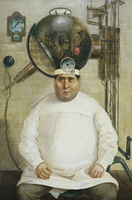Dr. Mayer-Hermann
Dix, Otto

Download105034_cp.jpg (792.0Kb)
Alternative Title
Bildnis des Laryngologen Dr. Mayer-Hermann
Date
1926Description
When Dix painted this picture of Wilhelm Mayer-Hermann, a prominent Berlin doctor, he was a favorite portraitist of Germany's cultural bohemia and its patrons. Yet his eye could be coolly unflattering. Dix had fought in World War I, a crucial formative experience: "It is necessary to see people in this unchained condition in order to know something about man," he said, and he came out of the war wanting "to depict things as they really are." Having experimented earlier with Expressionist and other modern styles, in 1920 he abandoned them for an approach and technique modeled on fifteenth- and sixteenth-century German art. In the process he was identified with what became known as the Neue Sachlichkeit (New Objectivity) movement, which advocated an unsentimental realism in the treatment of modern life.
Dix may portray the doctor exactingly, but the pose and the setting seem chosen to stress his rotundity. Everything is round: the face, the bags under the eyes, the double chin, the shoulders, the position of the arms, the tummy. A round lamp is affixed to the doctor's forehead, and the circular x-ray machine behind him reflects the room as rounded. Also behind him are a round clock-face and a round electrical socket. However precise the depiction, it verges on satire. full view
Type of Work
Oil paintingSubject
Germans, Physicians, Realism in art, Men -- Portraits, Painting, German --20th century, Art, Modern --20th century
Rights
Rights Statement
Licensed for educational and research use by the MIT community only
Item is Part of
131173